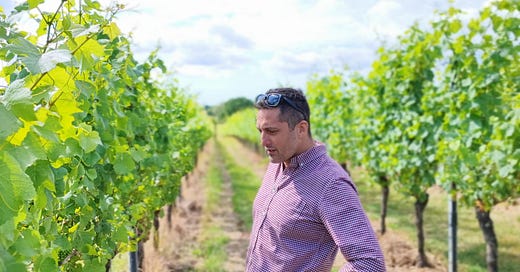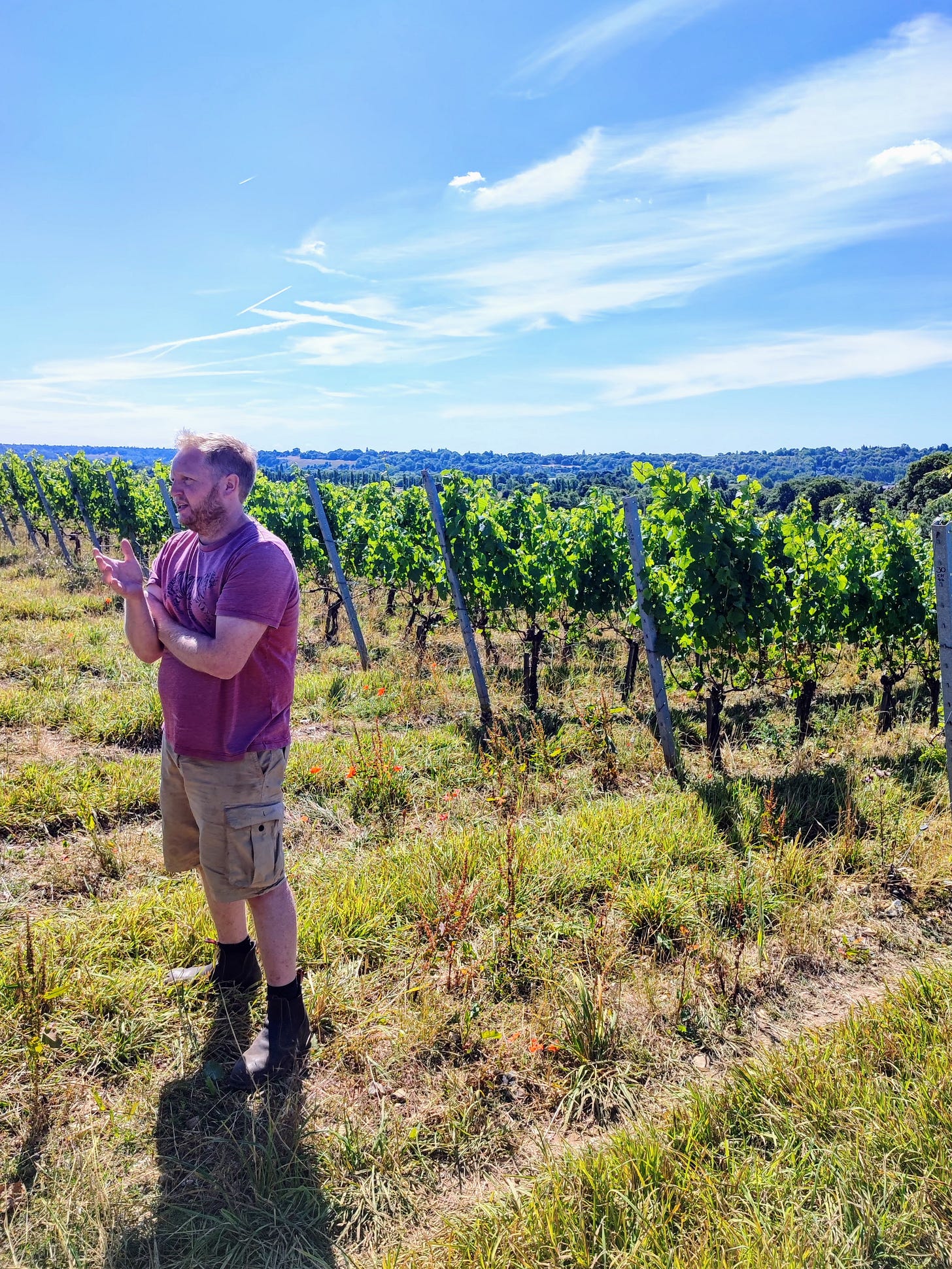Moving The Edge - Viticulture in England
"We've climbed the hill...and now we can see the city in distance"
Welcome, bubbleheads.
I recently assembled some of England’s most thoughtful vine-wranglers (as Emma Bridge calls herself) at the wonderful Oxeye in Vauxhall to look at how and why England’s wines are changing so quickly. Having tasted and rated 300 English wines for the timatkin.com England Special Report last summer, the most interesting question in England still remains: how do certain producers seem to reliably coax out fully-rendered, ripe and complete wines more often than others?
Sparkling wines can get away with a few gaps for a glass when you’re spitting feathers* - a glass of bubbly, tangy, apply-toasty is fine, thanks - but England’s top tier are now wines you can actually continue to enjoy once those feathers have all been ejected. It’s easy to get a bit technical when tasting bubbles, but that essential completeness and balance is the first hoop to jump through before any thoughts of style, oak, age, malolactic, texture and so on get a look in. Still wines arguably have an even harder job when it comes to first impressions.
We looked, then, at what goes into some of the country’s top-performing vineyards. The sites themselves, the soils, the viticulture. It’s not only climate moving the edge; it’s people.
*a favourite Anglicism for parched
Chalk and Cheese
Charlie Holland, Gusbourne Estate, Appledore, Kent
Gusbourne were the highest scoring producer overall for sparkling in the report, so CEO and winemaker Charlie Holland kindly came to show us their single vineyard project - a limited run of both Chardonnays (tasted here) and Blanc de Noirs showcasing the estate’s two main vineyard areas in Kent and Sussex.
It’s rare to be able to taste two finished sparkling wines made exactly the same way by the same winemaker in the same vintage (at least in England). The differences between the chalky Sussex Selhurst Park Chardonnay 2017 and the rounder, more open Kent Commanders Chardonnay 2017 were a solid reminder of how varied sites can be, even when chosen by one producer. “The two wines were picked a month apart, with the same analytics”, Holland explained. The Commanders is mainly planted to Burgundy clones on its Weald Clay over Tunbridge Wells sand at around 45 metres altitude. Selhurst is mainly Champagne clones on chalk at 85 metres.
Both last summer and here I found the Selhurst Park the more engaging of the two, with a true-to-type, raspingly-refreshing chalkiness and follow-through. I often feel as if much of what is put down to ‘chalkiness’ in English sparkling wine is just a certain tension and narrowness, possibly with some extraction and bright acidity. A sort of shadow-expression. This is different, though. The Commanders from Kent is admittedly a little easier to love, although tasting the final blended Blanc de Blancs from 2017 was a reminder of exactly why those producers able to combine a range of ingredients tend to make the best wines.
In terms of successful single-site vineyards, though, few have managed to rack up the consistent results that Harrow and Hope have from their site near Marlow in Buckinghamshire. Henry Laithwaite came to talk to us about their switch to organic viticulture, something that is still regarded as a bit of an extreme sport in the UK. Before going organic, Henry was blessed with a problem few English growers encounter - generous yields - and another one that most certainly do: high vigour.
“It was an opportunity to just to reduce yields, balance out the canopy and get more light penetration. Before it was just wall-to-wall leaves. I can actually see through my canopy now!”, he explained. Organic nutrition and cover cropping meant the vines were less pushy, the canopies were better aerated and less susceptible to disease, and the vines were not trying to take up more space than they were allotted in Harrow and Hope’s fairly tightly-packed vineyard of 5,500 vines per hectare.
Henry Laithwaite at Harrow and Hope, Summer 2022
We tasted both the Harrow and Hope Brut Reserve no.6, based on 2017 once again, with an interesting counterpart - the Wyfold Brut 2016, a wine which Henry makes from his mother’s gravelly, high-altitude plot in Oxfordshire. Yields are much lower here: “If she was churning out 10, 12 tonnes a hectare here they’d really struggle”, Henry explained. “It’s a pretty brutal soil - we’ve been trying to build organic matter in it. If you take away the stones you’re left with a lot of sand, which sort of explains the light frame and fragrance of the wines.” These are both, loosely speaking, wines of the Chilterns. Their difference, though, was perhaps even more marked than that of the two Gusbourne wines; a reminder that geographical closeness does not mean wines are going to taste similar.
Next I poured three diverse wines that all scored highly in the report: Ridgeview’s Limited Release Blanc de Blancs 2009 Magnum, Roebuck Estates Rosé de Noirs 2016 and Missing Gate Pinot Blanc 2020. The Ridgeview really shone. In a way it’s a simple beast in its conception; singular fruit of perfect ripeness, clear-eyed winemaking and long, long ageing in magnum. The end result is nothing simple, though; it’s still the highest score I’ve ever given to an English sparkling wine. The Roebuck was in a delightful place and charmed more than a few with lots of supple, pretty Pinot fruit, sitting between youthfulness and slightly more relaxed, complex maturity. Coming after these the (still) Missing Gate was admittedly a bit of a gear change with its concentration and body, lined with oak (and served a bit warm unfortunately), but I it’s an impressive statement for this underrated variety in England.
As we tasted, we heard from Emma Bridge, someone I first met wrangling vines at Fox & Fox in East Sussex. Emma is a ‘muddy person’ - not a viticulturist, but a grape-farmer (in her words), a hired hand rather than someone representing a particular brand. Accordingly we got a funny, wry and refreshing take on the realities of vineyard work in the UK. Very much zero dosage.
Emma pointed out that the vast majority of people making wine in the UK are still doing so as a second career, and “you probably had to have been pretty good at the first one in order to make enough money to buy the wine to teach you you wanted to move into the second one”. We heard about where the labour situation is in the UK (surprise, surprise, there isn’t enough - and Brexit, the pound and inflation has made foreign and contract labour more expensive) and many of the critical - if less glamorous-sounding - jobs that go into maintaining a vineyard once the all-important mud has been consecrated.
It ain’t pretty, but it works - time to look again at Essex clay
Finally, it was time to head East. There’s no chalk here, but the mud, Danbury Ridge’s viticultural consultant John Atkinson MW explained, is actually pretty interesting stuff. I’ve learnt far more from John than I can realistically put on paper here, but the general gist of it is as follows: parts of Essex will soon be warmer than Burgundy was in the 1960s, and the best sites are already reliable at ripening Pinot Noir and Chardonnay for still wine. This much we know (and we have the wines to prove it). It’s now about what comes next.
“We’re in the right place to go to the next level. We’ve climbed the hill, and in the distance, you can see the peaks”, Atkinson explained. You won’t see pictures of the Danbury team kneeling by the vines thoughtfully proffering lumps of clay in hommage to their chalk-bearing brethren on the South Coast (or indeed in Champagne), nor will you encounter perspex tubes full of soil profiles in Danbury Ridge’s tasting rooms (they’d all be brown, in any case). What you will see, if you ask, is an erudite explanation of why all clay is not born equal. And why some is very, very promising.
How so? Specific types of ‘smectite’ or shrink-swell clays hold a rare combination of managed water availability, drought-proofing and downpour resistance (we are still in England, after all), all of which promotes a gentle, well-timed stress on the vines in cool climates and prevents dilution, excess vegetative vigour or delayed ripening. Some other clays don’t have these properties, tending to crack when dry and, counter-intuitively, restrict the vine’s ability to extract water (even when wet). Rainfall amounts are projected to drop from around 550mm per year to 500mm in the area (about the same as the Ribera del Duero in Spain), so water availability becomes something to think about.
Smectite clays are hardly breaking news in winemaking. Atkinson maintains they’re one of the properties that makes Pétrus in Pomerol and the Chambertin Grand Cru in Burgundy what they are (and their neighbours what they aren’t). We tasted Danbury Ridge Chardonnay 2020, the best wine yet from Danbury, as well as the Pinot Noir 2020. The Chardonnay really is a marvel, a wine that manages to retain an English sort of bright-eyed energy even though the intensity, shape and saturation of flavour place it in a ballpark with some internationally-significant wines. The Pinot Noir is full of promise, although the 2020 vintage is in need of a little time in bottle still. Where other English examples seem to have the ripeness down on paper, Danbury’s seems to have both voltage and amplitude dialled in.
Catch-ups over lunch by the wonderful Oxeye team were a great reminder of how supportive and collegiate the UK wine industry is. Aside from the large trade tasting put on by WineGB there are painfully few cross-producer events (let alone ones where, as one winemaker pointed out to me, you could sit down and taste). Here’s to a few more in the future.







An interesting article, although I thought we might get a bit more about the actual viticulture. Harrow & Hope's high density, which is 50% higher than a lot of UK vineyards, is definitely his secret weapon, and results in a longer growing season, better yields (which I suspect will drop now that he's organic) and riper grapes. Danbury is pushing clay, because that's all they've got and dissing the Weald of Kent for having the wrong type of clay doesn't help their cause.